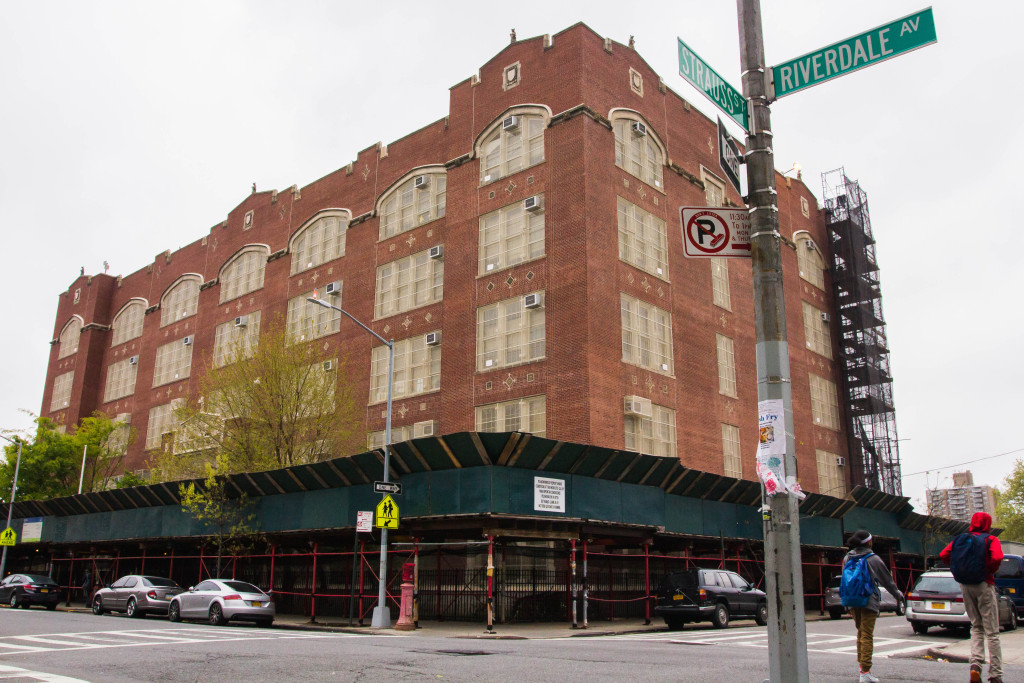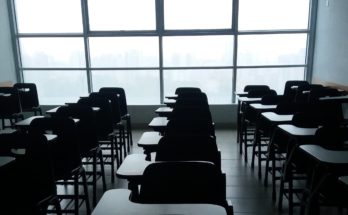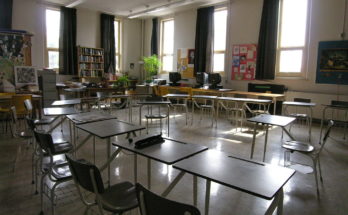
By 7:45 a.m. on a snowy March morning in Brownsville, a group of a half dozen elementary school students had already gathered at the entrance of P.S. 446. The young kids scooped up fresh slush from the tops of cars and began hurling it at each other. They raced up and down the Riverdale Avenue sidewalk, dodging incoming snowballs and passersby.
After five minutes, the small group swelled to more than 20 students. Aside from two parents who were waiting with their small children, and the occasional teacher coming to work, there were no adults in sight.
The students of P.S. 446 mingled with middle school students from Riverdale Avenue Middle School, which occupies the fourth and fifth floors of the same building. About 300 students from grades Pre-K to fifth grade attend P.S. 446. Riverdale Avenue Middle School houses grades six through eight, with a total of about 100 students.
“A lot of them, the parents work,” said Annette Blackwood, one of two PTA coordinators at P.S. 446. “The kids just get dropped off.” She added that parents realize that there’s no one at the school to supervise students before 8 a.m., but sometimes, they rely on other parents who might be waiting outside the school to keep an eye on their kids. Dropping children off too early is better than risking them not making it to school at all.
Classes at P.S. 446 start at 8:30 a.m., but students can come inside for free breakfast starting at 8 a.m. Students arriving earlier are not allowed to enter the building, even if it is extremely cold or snowy outside. Some students arrive as early as 7:15 a.m., idling outside the schoolhouse doors or aimlessly wandering the block until their classmates start to arrive. Moments before the building opens, even more students stream out of nearby delis and apartment buildings to scurry into the school.
Most schools finish class around 3 p.m., but the traditional workday ends at 5 p.m. As a result, schools across the city, including P.S. 446, offer robust after-school activities for children whose parents work later or for students who need and want enrichment classes, homework help or to participate in an extra-curricular activity like sports or music. But there is also a growing need for before-school programs. In poor neighborhoods like Brownsville, where 37 percent of residents are living below the federal poverty line and 16 percent of students are living with their families in homeless shelters, families need more support before and after the normal school day.
The school wants to be there for parents who need to drop their kids off at school early, and Principal Meghan Dunn would love to start before-school programs. The problem is money: P.S. 446 simply does not have the funds to cover the costs of before-school programs, which include paying for extra building security, paying teachers to work longer hours and obtaining the extra training and state certification for the staff members who lead the programs. Dunn estimated that opening the building just one hour earlier—at 7 a.m. instead of 8 a.m.—would tack on about $27,000 per year to the school’s budget for building staff, two teachers and a paraprofessional.
Dunn has tried to find the money on her own. She has applied for numerous federal grants, and has applied several times to participate in Mayor Bill de Blasio’s Community Schools Initiative. There are currently 130 community schools operating at the elementary, middle and high school levels throughout New York City, and 43 of them are in Brooklyn. City-designated community schools are expected to serve as neighborhood hubs where students not only receive academic instruction, but also as a community center where families can access social services.
Dunn said her application to become a community school was denied every time. The reason? Her school has successfully overcome many odds.
“The unofficial response I got was, we are ‘too high functioning,’” Dunn said, noting that the school’s test scores are too high, the number of safety incidents too low and community perception too positive to warrant any extra help.
According to New York State standards for measuring school quality, P.S. 446 is in “good standing.” Compared to the rest of the state, the school is meeting or approaching targets in all areas—teaching, school leadership, relationship with the community and student achievement. But its success is still limited. Last year, only 26 percent of fifth grade students met the standards for the state English test, compared to 30 percent of students across New York City who performed well. Only 35 percent of fifth graders met the standards in math, just below the city average of 39 percent.
At a PTA meeting this April, six mothers gathered in one of the gymnasium spaces at P.S. 446 to brainstorm their own solutions for tackling the problem of early student arrivals. They acknowledged that there’s potential to use this time before school in a constructive way: if the students are already getting to school early, it’s a great chance to pack in some extra tutoring or teach them a new skill, like cooking or music.
But the conversation quickly shifted to students’ safety. In a neighborhood that experiences over 100 incidents of violent crime, such as robbery, assault or rape per month (Manhattan’s Upper West side reports about half that number each month), parents know that kids can’t be outside unsupervised.
The mothers talked about asking parents to volunteer to watch the kids and about finding a daycare to serve as a designated drop-off location for students with nowhere to go. Those ideas were quickly dismissed: parents who are homeless or visiting food pantries to feed their families don’t have money to spend on childcare. They also pointed out that the neighborhood lacks safe and reliable childcare providers. Few have the proper New York State license to operate. They also mentioned that there are simply too many kids. A handful of parent volunteers can’t be asked shoulder the burden—or the liability—of the safety of dozens of students.
One of the mothers at the meeting, Natalie DuBose, is the parent of a first grader at P.S. 446. She’s active in the school community and volunteers as the PTA secretary. She’s a single mother. She’s also homeless. DuBose currently lives at a friend’s home near P.S. 446, but she and her daughter have been in and out of shelters throughout the city—sometimes as far from her daughter’s school as the Bronx or Far Rockaway—for the last two years. She has taken her daughter out of school at P.S. 446 twice since she started Pre-K.
“The only thing we have left is the school system,” DuBose said. “This school, it helps.” DuBose has lived in Brownsville for about 12 years and would like to stay in the area, especially since the school community provides stability for her and her daughter. She said that it’s extremely difficult to locate reliable resources, whether it’s information about navigating the shelter system, access to employment listings or organizations providing safe and qualified childcare.
Amir Brann is the Social Work Director at P.S. 446. He works for an organization called Partnership With Children, a non-profit social work agency that places teams of social workers in schools throughout the city to provide students and families with emotional and social support. Parents often come to him looking for help with researching employment opportunities and ways to acquire healthcare. Recently, many parents have needed help navigating the public housing system or with resolving disputes with landlords.
“Schools have a unique opportunity to be a centralized provider of many of those services, or at least be a hub that can connect people,” Brann said. Also as someone who works in the neighborhood, Brann observed that families have few places where they can go to feel part of a community and ask others for advice or support. The school is one of the few institutions in the neighborhood that is not only a reliable source of information and guidance, but also a place for parents and students to feel safe and connected to a support system.
DuBose echoed his observations, noting that the school is doing a good job but still needs to do more to reach out to parents in the community who might be struggling—whether it’s because they’re having trouble with getting their kids to school on time, or getting them to school at all.
“We need more support,” she said. “We need to know that the school is for us.”
By 8:15 a.m. on a Wednesday in April, just minutes after the school doors opened, the cafeteria at P.S. 446 is buzzing with students juggling backpacks and trays of breakfast food. Two fourth grade students sat at the end of a table in a quieter corner of the cafeteria.
Both of these students live about 20 minutes away from school and rely on public transit to get there every day. The girl eyed her math homework as she described her morning commute. She often travels with her siblings and cousins, who also attend P.S. 446 and the adjoining middle school. Sometimes, they leave their home early to compensate for delayed subway trains and end up waiting outside for the doors to open.
When asked why students arrive at school so early, the boy didn’t hesitate to offer his opinion.
“I know why, because they want to eat breakfast,” he said in between mouthfuls of pancakes and sips of milk. “Because they don’t want to be late for school.”
He reached for his classmate’s unopened juice box and asked if she was going to drink it. She nodded and motioned for him to take it, barely looking up from her workbook as she struggled to complete her math homework before the bell rang at 8:30 a.m.
Correction: The original story said Amir Brann lives in Brownsville. He does not. It has been changed to “as someone who works in the neighborhood.”



